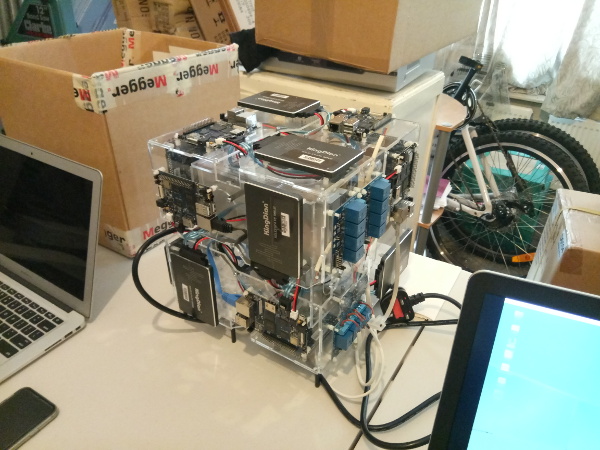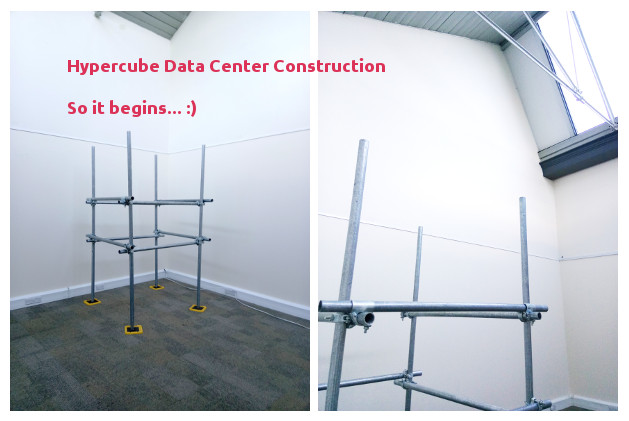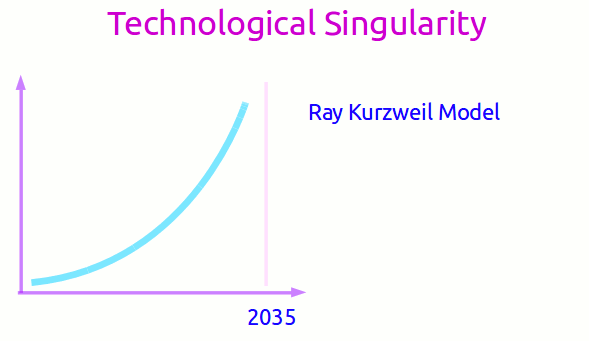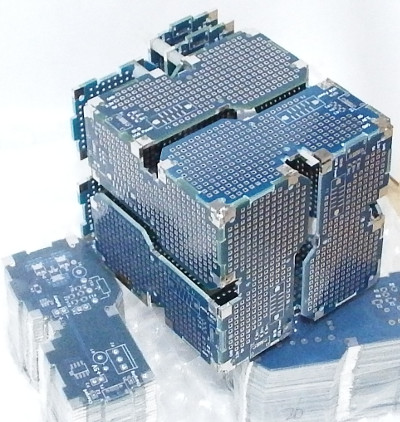Hypercube Developer Website
Hypercube Data Center (TM)
 The rational behind a Synthetic AI Hand Project is straight forward. The entire human race civilization is built by a pair of hands duplicated over and over again doing the little things that collectively becomes civilization. So if we could make a pair of really good AI infused synthetic hands, only one pair of hands would ever get built, and the rest are all just duplicates. Project details: Synthetic AI Hand Project |
Imagine a room filled with 3D wired Hypercubes like these:  The Hypercube above is 44 core supercomputer array with SSDs running Linux with Apache web hosting and ftp upload for IoT cameras. Arrays of these is what makes a Hypercube Data Center (TM). The photo below shows how it all starts...  Hypercubes stacked in a 3D arrays leads to 3D wirable computer system which are used to make 3D wired Hypercube Data Center. The construction of the data center begins with a 3D lattice of scaffolding. The 3D lattice reaches into every corner of the building and then the Hypercubes are fitted together whilst being supported by the scaffolding. Eventually the Hypercubes 3D array stands on its own supports. The scaffolding is removed leaving behind a 3D wired Hypercube Data Center (TM). With help of China lead investor, we move into new office to perfect practical construction.  The Technological Singularity is coming - but why is it so important to the Hypercube? Ray Kurzweil is an incredible genius who noted that human technology is evolving at an exponential path - most notably information technology. If this pace were to continue then by around 2035 technological evolution would become exponential and vertical. But there is currently a problem. We are supposed to be in the era of 3D computer chips today as Moore's Law is tailing off and unable to keep up with demand. The next best thing for 3D wired computer technology is a 3D wirable computer array. Hypercubes are just that - a 3D wirable system positioned right at the cusp of disruptive change where we are to transition from 2D electronics to 3D electronics. Hypercubes allow the construction of 3D wired computers and Hypercube Data Centers. A Hypercube Data Center we calculate with today's technology the size of 3km x 3km x 300m of Hypercube can contain enough data storage and processing power to simulate a brain in every detail with every neuron and every neuron interconnection modelled with 1 yottabyte of storage. Will that machine think like a human? No one can tell today. If every neuron and its interconnection has been modelled (the data having been first extracted through slicing a brain a few nano meters deep and imaging all the detail), this brain will wake up with all its memory in tact and electrical activity in the simulated neurons flowing in the same way as the real brain. We will simulate the eye and auditory senses, and a way to control output voice synthesizer, and thus this brain will have the same input as real eyes and ears and be able to talk back. If it is living, it will respond back with the same thoughts as the original person. If the person was a science graduate, we could ask them to solve complex problems and speed up the electrical activity such that this brain is operating 10 to 100, may be thousands to millions of times faster than a human brain, and we get answers out quicker. The technological singuarity curve tells us that the price of 1 yottabyte storage built with Hypercubes will halve every year and its size and power consumption will also halve. What is incredible is that we rapidly arrived at a point in time where technology has advanced so much to the point where we are able to do all of these operations with a methodical plan. |
 Hypercube PCBs come with their own interchangeable software to mix and match functions as needed. Designed around IoT needs, we make prototyping work fast and effortless. |
| Home | ||
 Electronics Store Opening Soon |
||
Copyright (C) Hypercube Semicondutors 2018 |